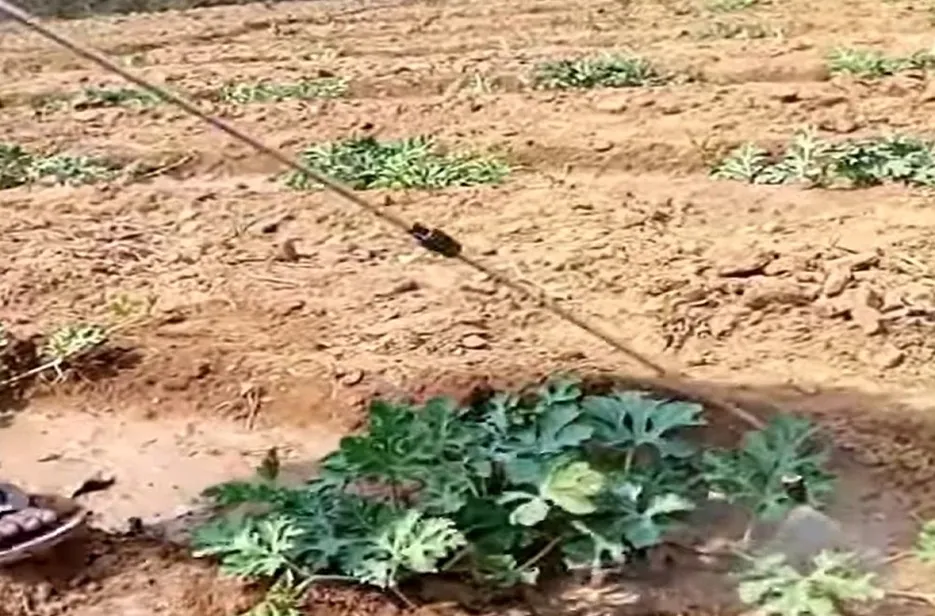 மீண்டும்
மீண்டும்

What soils and Climate are suitable for watermelon?
What soils and Climate are suitable for watermelon?
Water melon is generally grown in warm season Light, well-drained soils that have good water-holding capacities are preferred. The plants need a constant water supply for the fastest growth and best yields, but excessive water application should be avoided, as the roots are susceptible to root diseases in wet and poorly aerated conditions. The soil pH should be between 6.0 and 6.5 for optimum growth. The crop requires a tropical climate with a fairly high temperature (35-40 C) during fruit development.



Land preparation and sowing practices of watermelon
Land preparation and sowing practices of watermelon
➥. Land preparation involves 2-3 tillage operations performed to make the soil more suitable for seeding and seedling establishment, to enhance productivity by providing the best soil structure for root growth and development, and to ward off some disease problems. Organic manure should be broadcasted uniformly around 7-8 tonne per acre in the field


➥The row to row spacing should be 150 cm, and the distance of the plant at 45 cm.
➥Seeds should be planted 2-3 cm deep in the soil and the amount of seed required for one acre is 300-400 g.
➥Plant the seeds on raised beds with drip irrigation and plastic mulch for better growth. Plastic mulches can increase earliness and yield, and black mulches can help suppress weeds in the planting beds


Fertilizer requirements of watermelon
Fertilizer requirements of watermelon
➥ Fertilizer application depends on the soil type, fertility level, soil organic matter and cultivation system. Generally first dose after sowing is 25:50:50 NPK/ acre and dose after 30 days of sowing is 25:00:50 kg/acre


➥ Apply of 500 g of boron per acre. Two to three foliar applications of water-soluble boron at weekly intervals coinciding with the opening of the first female flowers enhance pollination and improves the fruit set.
➥ Field should be kept free from weeds until harvesting as some weeds act as carriers of viral diseases and insect pests which may affect the watermelon crop adversely.


Care to be taken during the flowering of watermelon
Care to be taken during the flowering of watermelon
➥ After each irrigation earthing should be done to break the soil’s crust and keep granular surrounding the base of the pit.
➥ Watermelon produces imperfect female and male flowers. The male flowers are produced at every node during flowering and female flowers at approximately the seventh node.
➥ The actual number of fruit set depends on variety, cultural practices, environmental conditions, irrigation, and population of pollinating insects


Pollination
Pollination
➥ Watermelon flowers are viable for one day, hence an adequate population of pollination insects must be available every day during the flowering period.
➥ Honey bees are the main pollinators for water melon, and there should be at least one colony of bees per acre during flowering to obtain the maximum fruit set. Each flower needs to be visited 10 to 15 times by honey bees to ensure adequate pollination.


How to overcome disorders in watermelon
How to overcome disorders in watermelon
➥ Blossom end rot is a physiological disorder related to calcium deficiency, moisture stress, or both. It can be prevented by the application of calcium through nutrient sprays.
➥ Hollow Heart or White heart are two physiological disorders influenced by genetics, environment, and a number of nutritional factors. To control this, crop should be grown under optimal nutritional and moisture conditions.
➥ Sunscald is the damage to the melons caused by intense sunlight. It can be reduced by developing and maintaining adequate canopy cover to afford protection


Major diseases of watermelon
Major diseases of watermelon
➥ It is important to keep plants healthy and protected from diseases. Leaf damage and poor plant health at the end of the season can result in lower quality melons with reduced levels of sugar and poor flavor. Major diseases of watermelon are Powdery mildew Anthracnose Fruit rot.
➥Fusarium wilt- drenching with Bavistin (1.5 %) or Ridomil MZ (1.5 %) after transplanting as a preventive measure Spraying with best and safe fungicides will help in managing diseases like powdery mildew, Anthracnose and Fruit rot Major Insect pests of watermelon


Important insect pests of watermelon
Important insect pests of watermelon
➥ Major insect pests are Aphids (whitefly, ringworm, leaf minor) and Thrips Insects of watermelon can be controlled by spraying insecticides 5-6 times during crop growth. Spray recommended insecticides to control whitefly and thrips.




The maturity of watermelon may be judged by
The maturity of watermelon may be judged by
➥ Dull sound when the fruit is thumped
➥ Withering of tendrils at the fruit axil
➥ Ground spot (where the fruit is touching the ground) turning yellow


Harvesting of watermelon
Harvesting of watermelon
The time of watermelon harvest is determined by fruit maturity, not by fruit size. Watermelons’ fruit quality and flavor are best if the fruit is harvested when they reach full maturity. Mature melons continue to ripen after they have been harvested, but the soluble solids content of the fruit does not increase after harvest. Factors used to determine maturity include the level of netting on the fruit, the background color, and the soluble solids content (average Brix value). The average marketing fruit yield is 50-55 tonnes per ha depending on the variety and crop management practices followed.


Thank you for reading this article, we hope you clicked on the ♡ icon to like the article and also do share it with your friends and family now!










